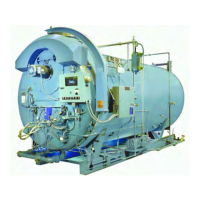Chapter 3 — Waterside Care and Requirements
Part No. 750-184 3-9
your local Cleaver-Brooks authorized representative for
recommendations, cleaning compounds, and application
procedures.
2. PRESSURE VESSEL
The waterside of the pressure vessel must be kept clean from
grease, sludge, and foreign material. Such deposits, if present, will
shorten the life of the pressure vessel, will interfere with efficient
operation and functioning of control of safety devices, and quite
possibly cause unnecessary and expensive re-work, repairs, and
down-time.
The installation and operating conditions that the boiler will be
subjected to should be considered and cleaning of the waterside of
the pressure vessel should be provided during the course of initial
start-up.
The pressure vessel and the steam and return lines or hot water
piping represent, in effect, a closed system. Although the steam and
return (condensate) lines or the hot water piping system may have
been previously cleaned, it is possible that:
(1) Cleaning has been inadequate.
(2) Partial or total old system is involved.
(3) Conditions may prevent adequate cleaning of piping.
The pressure vessel waterside should be inspected on a periodic
basis. An inspection will reveal true internal conditions and serve as
a check against conditions indicated by chemical analysis of the
boiler water. Inspection should be made three months after initial
starting and at regular 6-, 9-, or 12-month intervals thereafter. The
frequency of further periodic inspections will depend upon the
internal conditions found.
If any unwanted conditions are observed, contact your local
Cleaver-Brooks authorized representative for recommendations.
Any sludge, mud or sediment found will need to be flushed out. If
excessive mud of sludge is noticed during the blowdown the
scheduling or frequency of blowdown may need to be revised. The
need for periodic draining or washout will also be indicated.
Any oil or grease present on the heating surfaces should be removed
promptly by a boil-out with an alkaline detergent solution.
Note: Temperature of initial fill of water for hydrostatic tests, boil-
out, or for normal operation should be as stated in the ASME
Boiler Code.
E. BOIL-OUT OF A NEW UNIT
The internal surfaces of a newly installed boiler may have oil, grease
or other protective coatings used in manufacturing. Such coatings
must be removed because they lower the heat transfer rate and
could cause over-heating of a tube. Before boiling out procedures

